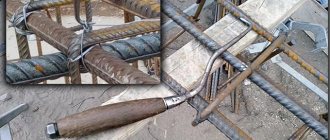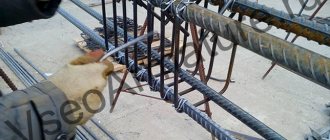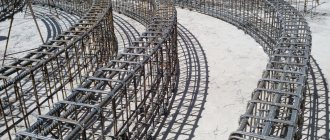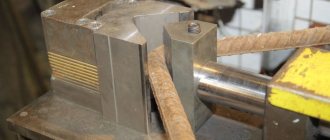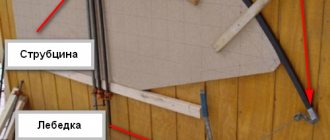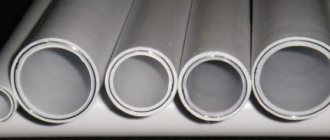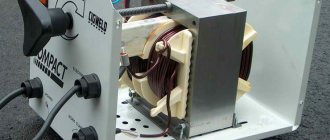Experienced builders know that the strength of the foundation under the walls of the house directly depends on the correctly chosen design of the reinforcing frame to create a strip foundation, and the correct installation. In this design, all the, so to speak, “responsibilities” of its constituent elements are clearly distributed. Thus, the reinforcement takes on deforming linear stresses that arise not only from the weight of the walls, but also from temperature changes, and the concrete part of the structure prevents its compression. Thus, together these materials create reliable support for the walls.
Tying reinforcement under a strip foundation is the best option for fastening the metal “backbone” of a reinforced concrete structure. Such a connection, while maintaining the given linear and spatial forms of the frame, nevertheless leaves the opportunity to somewhat “balance” when the concrete hardens and gains its grade strength, taking the optimal position when exposed to emerging loads. If you make the skeleton of the foundation rigid, that is, fasten the reinforcement by welding, then even with slight shrinkage of the soil or under pressure from the walls of the house, the concrete part of the structure may begin to collapse, since when the solution hardened, the optimal shift of the frame parts did not occur and in a seemingly strong monolithic the slab retains significant internal stresses.
A few words about the features of strip foundations
The strip type of foundation can be safely called universal, the most common, making it possible to construct buildings from almost any building materials. The widespread use of this foundation design is explained, among other things, by significant cost savings, simplicity and accessibility of its independent arrangement, as well as the fact that the strip foundation has been comprehensively tested by the very wide practice of its many years of operation.
Such a foundation itself is a reinforced concrete strip, which can have different widths, thicknesses and heights. These parameters depend on the design of the future building - the size of the walls and the material from which the walls are planned to be built, the overall massiveness of the structure, the condition of the soil at the construction site and a number of other important factors. But in any case, the strip foundation is installed along the perimeter of the future structure, has a closed contour, which is intended for the further construction of load-bearing walls. If necessary, this type of foundation is supplemented with internal lintels, which become the basis for the construction of intra-house capital partitions on them.
The depth of the tape base can vary significantly, depending on the specific circumstances. Thus, in case of unstable upper layers of soil at the construction site, the base of the strip base is completely buried below the freezing level or is performed in combination with a pile foundation. If the soil is dense, or when it is planned to build a building with a small overall mass, then it is quite possible to get by with a shallow strip foundation.
Be that as it may, the requirements for complete and high-quality reinforcement are equally important for any type of strip foundation. Only under this condition will the foundation optimize the load from the walls of the house on the ground along the entire perimeter of the building, which minimizes the risk of subsidence of the building, distortion and deformation of all its component building structures.
How to fill a strip foundation with your own hands?
In this publication we will not delve too deeply into the intricacies of the design of such a base. to the issues of calculation and sequence of work on independent construction of a strip foundation .
What kind of reinforcement is used to knit the frame?
So, moving on to preparing everything necessary for arranging the foundation, it is necessary to obtain information about which reinforcement is best suited for forming the frame of a strip foundation. Nowadays, “classic” steel and composite reinforcement can be found on sale in construction markets. Which one is better for a strip foundation is worth figuring out.
Metal fittings.
Steel reinforcement used to create frames for pouring foundations must comply with the requirements of current GOSTs. In residential construction, material manufactured in accordance with GOST-5781-82 is most often used. This standard regulates the parameters of hot-rolled reinforcement intended for use in conventional and prestressed building structures.
In accordance with the provisions of GOST, this fittings are divided into six classes. If for the first class ordinary low-carbon steel is used, then as the class increases, the content of special and even alloying additives increases, sharply increasing the mechanical strength of the material.
Class I reinforcing bars have a smooth outer surface. All others (with rare exceptions) are given a corrugated shape, the so-called periodic profile of annular, crescent or mixed type. This relief structure of the surface is intended for maximum contact of the reinforcing elements of the structure with the concrete gaining strength.
For the main reinforcement of a strip foundation, the optimal choice, from the standpoint of a sufficient degree of strength and reasonable price, would be class A-III reinforcement, with a diameter of 12 to 18 mm, depending on the features of the structure being created. The indicators of classes from the fourth and above will simply remain unclaimed, but A-II may turn out to be rather weak.
It is worth paying attention to the presence of a letter index.
- So, the letter “C” indicates that this reinforcement can be connected by welding. With all other types, welding work is completely eliminated - the structure of the steel changes during high-temperature heating, and the frame will lose the necessary strength.
- The letter designation “K” is used for products made of steel with increased anti-corrosion properties. They are usually used in the construction of objects that have special requirements, and for a strip foundation for private construction, the purchase of such reinforcement (and it certainly costs much more) does not seem necessary.
But for additional structural elements - lintels, racks, clamps, which give the main frame the necessary volume, smooth AI class reinforcing bars with a diameter of 6 mm (for a tape height of up to 800 mm) or 8 mm (for a greater height) are quite suitable. They are easily bent into the required configuration, and their strength characteristics are quite sufficient for such an application. You can also use corrugated rods of class A-II, but this will be somewhat more expensive.
Prices for fittings
reinforcement
Fastening of reinforcement is most often done using a special binding wire, which is installed and looped at all intersection points of steel rods. The use of welding is not recommended for several reasons:
- Any weld, even a well-made one, is a place with increased vulnerability to corrosion.
- Lack of penetration at the joint, which may not be noticed when installing the frame, can result in a violation of the integrity of the structure at the stage of pouring heavy concrete mortar.
- Even slight overheating of the rod at the point of its intersection with another structural element reduces the reinforcing qualities inherent in it.
So even if the developer considers himself an experienced welder and has a machine at his disposal, it is still better to refrain from such an operation. By the way, only masters of the highest qualification category are allowed to work on welding reinforcement structures, where it is necessary in industrial construction conditions. And in this case, only fittings marked with the letter “C” should be used.
Composite reinforcement
Composite reinforcement is a relatively new building material. It can be produced on different bases - fiberglass, carbon fiber or basalt plastic.
The most common in this category is fiberglass reinforcement, as it has a more affordable price compared to the other two types, while having high strength qualities.
Composite rods are used to reinforce various types of foundations, including strip foundations. The advantage of this type of reinforcement is its low thermal conductivity compared to metal rods. Therefore, these products are well suited for reinforcing foundations and basement walls that are planned to be insulated, since there will be no unnecessary heat loss due to this material.
Polymer reinforcement is inert to external influences, therefore it is quite durable - it is not afraid of moisture and fairly high temperature changes. If high-quality concrete and fiberglass reinforcement are used when arranging the foundation, the foundation for the house should be strong and durable.
Installation of polymer rods is much simpler than installation and fastening of metal reinforcement, since they are light in weight, easily fastened with clamps or wire and do not leave traces of rust on hands and clothes.
A comparison can be made with steel reinforcement based on basic indicators:
- Tensile strength, with equal diameter, for a steel rod is 390 MPa, for a fiberglass rod - 1000 MPa.
- Fiberglass has a mass 3.5 times less than steel.
- Steel is susceptible to corrosion, polymer is resistant to acidic environments.
- Fiberglass does not conduct electricity, unlike metal.
- Steel has a high thermal conductivity, while polymer practically does not conduct heat.
- Metal is a non-flammable material, while fiberglass is a low-flammable, self-extinguishing material.
- The elasticity of steel is several times higher than that of fiberglass.
- Polymers have great tensile strength, however, when heated to very high temperatures, the plastic binding fiber becomes soft, losing elasticity.
- Composite reinforcement is fastened only with plastic clamps or wire; metal reinforcement can be welded or twisted with wire.
From a comparison of the characteristics of these two materials, the conclusion suggests itself that for heavy buildings it is best to use metal reinforcement, and for light structures a frame for a fiberglass strip foundation is also suitable. However, there are several important nuances to keep in mind.
- To date, clear technological recommendations for the use of composite reinforcement have not yet been developed - all calculations are so far based on the use of steel products. So the owner who decides to use a fiberglass frame takes a certain risk.
- The market is literally flooded with fiberglass reinforcement of very dubious quality. This is not surprising - if the production of rolled steel requires extremely specific production conditions, then lines for the production of composite rods are advertised and sold to everyone who wants to try their hand at this business. Naturally, in this case there is no need to talk about any compliance with GOST - at best, compliance with independently established technical conditions (TS) is declared, in which the criteria for assessing product quality are either deliberately underestimated or unclearly stated. And very often, consignments of goods do not have any accompanying technical documentation at all.
Such rods may have longitudinal or transverse (noticeable on the cut) cracks, delaminations, protruding fibers, knots, resin drips, uneven curling pitch, color differences, which, in turn, indicates a clear failure to comply with the temperature-time processing conditions. It is difficult to say how such reinforcement will behave in a loaded state as part of a strip foundation frame, and hoping that it will “carry through” is not the most reasonable solution.
Connecting reinforcement with tying wire
The reinforcement is connected with knitting wire using a knitting hook. How to do this correctly - see one of the previous articles, in which I talked about knitting reinforcement for the foundation.
The connection of the reinforcement must be rigid; not only the strength of the reinforced concrete structure during its operation, but also the strength and integrity of the frame during the process of pouring concrete into a trench or formwork depends on this.
When concrete is fed from a machine into a formwork or trench, there will be vibration and pressure pressure on the connected units, and in order for the reinforcement not to warp, it must be rigidly connected.
Schemes for distribution of reinforcement in the structure of a strip foundation frame
As mentioned above, the reinforcement in the foundation structure contributes to the uniform distribution of the main load from the weight of the building and external dynamic influences, maintains the integrity of the structure under the influence of emerging internal stresses. Therefore, how well the frame elements are fastened, so strong and durable will be the foundation, which means and the entire building as a whole.
When arranging the frame of a strip foundation, you need to take into account some nuances:
- The greatest loads fall on the longitudinal rods of the frame of the upper and lower (especially) reinforcement belt. Therefore, taking into account the characteristics of the soil and the features of the future building, periodic profile reinforcement with a diameter of 10 mm or more is selected for them, and if the length of the tape in any of the sections exceeds 3 meters (and this is what happens most often), then at least 12 mm.
- Longitudinal reinforcement should be located at a distance from the bottom, side walls and the upper boundary of the cement mortar pouring at a distance of 30 to 50 mm. For example, if a foundation with a width of 400 mm is being built, the distance between the longitudinal rods in the horizontal plane should be 300 mm.
- The distance between two adjacent parallel bars of longitudinal reinforcement should not exceed 400 mm.
- For transverse and vertical elements of the frame, smooth rods with a diameter of 6÷8 mm are used (for a tape height of 800 mm or more - at least 8 mm). Such a section will be quite sufficient, since they bear less load.
- The distance between clamps (transverse reinforcement sections and posts) can vary from 100 to 500 mm. The last value is the maximum, so you cannot exceed it. It is best to proceed from the calculation that the installation step of the clamps is 0.75 × h, where h is the total height of the foundation strip.
- The number of tiers of longitudinal reinforcement and the number of rods will depend on the height and width of the strip foundation. SNiP establishes minimum ratios of the cross-sectional area of the tape and the total cross-sectional area of the rods of the longitudinal main reinforcement.
- If the load on the foundation is not too great, then the frame design is extremely simplified and is a rectangle in cross-section without additional reinforcing rods. That is, in the lower and upper reinforcing belts, two longitudinal rods are used, which are linked to vertical and horizontal jumpers or ready-made clamps.
Areas that require additional reinforcement are of increased complexity - these are corners and areas where foundation strips adjoin. This is discussed in detail in the corresponding article.
Prices for fiberglass reinforcement
fiberglass reinforcement
How to correctly calculate and plan the reinforcing frame of a strip foundation?
When building a large country house, it would be wiser to entrust this issue to qualified specialists. But if a small structure is being erected, then you can do it yourself - a special publication on our portal contains drawings of strip foundation reinforcement and offers convenient calculation calculators.
Maximum deviations in the diameter of knitting wire GOST 3282-74
| Nominal wire diameter, mm | Maximum deviation for wire diameter, mm | Nominal wire diameter, mm | Maximum deviation for wire diameter, mm | ||
| increased accuracy | normal accuracy | increased accuracy | normal accuracy | ||
| 0,16 | -0,02 | -0,02 | 1,10 | -0,05 | -0,06 |
| 0,18 | 1,2 | ||||
| 0,20 | 1,3 | -0,10 | |||
| 0,22 | 1,40 | ||||
| 0,25 | 1,60 | ||||
| 0,28 | -0,03 | -0,03 | 1,80 | -0,06 | |
| 0,30 | 2,00 | ||||
| 0,32 | 2,20 | -0,12 | |||
| 0,35 | 2,50 | ||||
| 0,36 | 2,80 | -0,10 | |||
| 0,37 | -0,04 | 3,00; 3,20 | |||
| 0,40 | 3,50 | -0,16 | |||
| 0,45 | -0,04 | 3,60 | |||
| 0,50 | 4,00 | ||||
| 0,55 | 4,50 | ||||
| 0,56 | 5,00 | ||||
| 0,60 | 5,50; 5,60; 6,00 | ||||
| 0,63 | -0,05 | 6,30 | -0,20 | ||
| 0,70 | 7,00 | ||||
| 0,80 | 8,00 | ||||
| 0,85 | 9,00 | ||||
| 0,90; 0,95; 1,00 | 10,00 | ||||
Wire for tying reinforcement cage
The reinforcement is knitted when installing the foundation frame using wire, the technical characteristics of which are specified in the documents GOST 3282–74.
The wire is made from low-carbon steel and is divided into several types:
- According to the processing method. There is heat-treated (annealed) and untreated wire.
- In terms of manufacturing accuracy. So, the wire can be of high precision or regular.
- According to the temporary resistance to loads and rupture of a product that has not undergone heat treatment, there are first and second groups.
- The wire may have a special protective coating or be without it.
The wire can be steel or black. The cross-section diameter varies from 0.16 to 10 mm. In this case, deviations in the cross-section of the product are allowed by 0.02 mm.
In GOST documents you can find more detailed characteristics of this product. Some of them:
- The elongation of wire that has undergone heat treatment and has a protective coating is 12÷18%, and without protection 15÷20%.
- For products not treated at high temperatures, depending on their cross-section, a parameter such as tensile strength varies and is (N/mm²):
— 590÷1270 for diameter 1.0÷2.5 mm;
— 690÷1370 for diameter less than 1.0 mm.
The manufacturer of these products must ensure compliance with the following GOST standards:
— products without heat treatment with a diameter of 0.5 to 6.0 mm must maintain integrity after four or more folds;
— the zinc protective coating must maintain its integrity and fit tightly into the steel after winding the wire in the form of a spiral. In this case, the presence of small zinc deposits, plaque, white sparkles and color heterogeneity is allowed;
— wire should be sold in coils. These coils can have different weights, which depend on the diameter of the wire and the presence or absence of a protective coating. Thus, the mass of the coil varies from one kilogram with a cross-section of products of 0.16÷0.18 mm to 40 kg with 6.3÷10 mm.
Heat treatment of the wire (annealing it) makes the material more plastic, easier to use, without significant loss of strength properties. So it makes sense to immediately purchase this option. Annealing, of course, can be done independently - but is it worth spending effort on this when ready-made wire is already on sale, and at a more than affordable price?
Probably, for a strip foundation there is no particular need to purchase zinc-coated wire if concrete is poured immediately after installing the reinforcing frame. In such a short period of time, corrosion will not have time to “gobble up” the connections, and then, after the concrete has fully matured, it will not be terrible at all.
As a rule, when constructing strip foundations independently, wire with a diameter of 1.2 or 1.4 mm is used, less often - up to 1.8 mm. The millimeter one is still rather weak for such purposes - it can cause breaks when tightening the knots, and with a diameter of 2 mm or more it will be very difficult to work with, it will take a lot of effort for high-quality tying without any special benefits.
The construction market has been replenished with another extremely convenient material for knitting frames. These are coils of ready-made wire segments with a diameter, as a rule, of 1.2 mm and a length of 80 to 180 mm, already having ready-made loops at the ends. Usually there are 1 thousand of these products in a bay.
The cost of such packages of wire loops is very affordable, and labor productivity, as practice shows, almost triples.
Below, the reader is offered a calculator that will help to quickly calculate approximately how many connection points will need to be connected to the reinforcement frame being created, and how much wire will be required for this. It is taken into account that some areas of reinforcement require additional reinforcement.
Calculator for calculating the amount of wire for tying the reinforcement cage of a strip foundation
Go to calculations
It should be correctly understood that this is the minimum required amount of material. During work, it is quite possible that the tightened knots will break, your work will be defective, and it’s easy to drop and lose cut pieces of wire at a construction site. Its cost is low, so it is quite possible to lay down a reserve of 50 or even more percent. Moreover, since the construction of the foundation is still underway, there are still many different construction operations ahead, and there will always be a use for excess wire.
What types of tying wire are used for tying reinforcement
There are two main types of knitting wire - regular wire and fired wire.
As a rule, the second option is used for tying reinforcement. Moreover, regardless of what the reinforcement frame is intended for, be it any type of foundation, or some other reinforced concrete structure.
In order for the wire to become processed, it is enough to heat it well, in other words, harden it. After thermal hardening, it becomes more flexible, more durable, and also more resistant to various atmospheric influences.
In addition to everything, the treated knitting wire has virtually no stretch, which will give the knot additional strength.
In the store you can also find galvanized and non-galvanized wire. Any of them is used for tying reinforcement, but galvanized is slightly less susceptible to aggressive environments.
Tools for tying reinforcing bars
It is almost impossible to fasten reinforcement with wire manually, that is, simply with the efforts of your fingers, so special tools, both manual and mechanical, were created to carry out this process. These devices and devices will not only speed up the work, but will also significantly improve the quality of the reinforcement element bundles.
So, knitting rods into a reinforcing structure under the foundation can be done with the following tools:
- handmade crochet hooks, factory-made or homemade;
— inertial crochet hook of semi-automatic action;
- a special knitting gun;
In addition, for the knitting process they learned to use a regular electric drill (which switches to low speed) or a screwdriver with a special homemade hook attachment.
- Knitting gun
The highest quality binding is obtained when using a specialized knitting gun. But this is a fairly expensive tool, and in order to make only one foundation, rarely anyone buys it. Basically, professional builders have it in their set of tools, since, moving from object to object, they cannot waste much time on the already rather lengthy and labor-intensive operation of linking the frame.
Prices for a knitting gun
knitting gun
For the pistol, special replacement coils are produced with wire wound on them, with which the device is charged. Many of these tools can be powered by a battery, and since two batteries are usually included with the knitting gun, work can proceed almost uninterruptedly. Another advantage of such a device is that it is not connected by a cable to an outlet, so it can work in autonomous conditions - in the absence of nearby network connection points.
The tying gun grabs the desired area of the metal rods, releases the wire and loops it around them, and then twists the edges of the wire together. The disadvantage, besides the high cost of the device itself, is the inability to work in some hard-to-reach places, where you still have to switch to “manual labor”.
- Crochet hooks
A universal device for tying reinforcement in the foundation frame can be called a crochet hook, since it can be used in the most inaccessible and narrow places. The hooks are small in size, so they are quite convenient for tying rods in a narrow trench under a strip foundation.
Hooks may vary slightly in appearance and configuration, so when purchasing this tool, you should ask to test it on site. The tool that fits comfortably in the hand, which means it will be more comfortable to work with, is worth choosing for further work. Keep in mind that an uncomfortable hook can quickly cause calluses on your fingers.
A homemade hook is made like a factory model, repeating its shape. To make it, you can use a sharpened piece of reinforcement, which is bent in a vice and then inserted into the handle. The handle can be made from molten plastic by screwing it onto the fittings, or by placing a thick-walled polymer tube on it, heating it and then cooling it. When cooled, the plastic will press tightly against the fittings, forming a handle convenient for working manipulations.
Another option for a crochet hook, the design of which will significantly speed up the work of installing the frame, is a semi-automatic tool that operates on the inertial principle.
The hook itself is located on a kind of leg, which has grooves cut into it like a spiral. There is a return spring mechanism located inside the hook handle.
This tool works as follows: hook loops of wire and pull them up, applying force. At this time, the leg, when leaving the handle, when moving the spiral grooves along the guide protrusions, rotates, making several turns, twisting the two ends of the wire together until the knot stops against the fastened elements of the frame structure. If necessary, the operation is repeated until the required tightening of the unit is achieved. Thus, just one or two forward movements are required to link the point.
A hook attachment installed in a drill or screwdriver will speed up the work with less physical effort. These tools quickly twist the two ends of the wire until they stop, securely fixing the crossed reinforcement together. It is easy to experimentally set the optimal tightening torque on a screwdriver ratchet. It will be more convenient to work with a compact tool, since the trench space for a strip foundation is often very limited. In addition, if you plan to use a conventional electric drill to tie the reinforcement, you will need to stock up on a multi-meter extension cord.
Whatever knitting tool is chosen, the principle of twisting the wire is the same, so its choice depends on the financial capabilities and preferences of the master.
